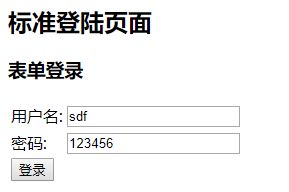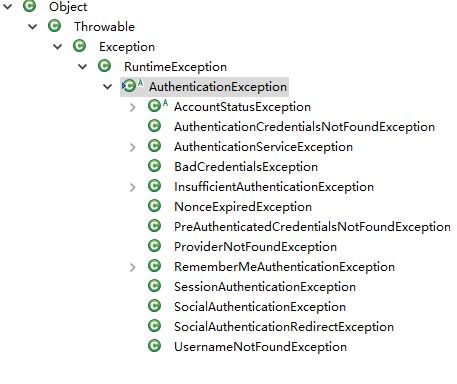个性化用户认证流程
- 自定义登录页面
- 自定义登陆成功处理
- 自定义登录失败处理
自定义登录页面
之前我们使用SpringSecurity默认配置的登录页面,如表单登录或者HTTP BASIC登录,这里我们想自定义登录页面。首先我们修改安全配置:
@Configuration
public class BrowserSecurityConfig extends WebSecurityConfigurerAdapter{
@Bean
public PasswordEncoder passwordEncoder(){
return new BCryptPasswordEncoder();
}
@Override
protected void configure(HttpSecurity http) throws Exception{
http.formLogin()
.loginPage("/login.html")
.and()
.authorizeRequests()
.anyRequest()
.authenticated();
}
}
在configure方法中指定了登陆页面的URL后病并且在项目的/src/main/resources/下建一个resources文件夹,这个文件夹里面放的是项目的文件默认放置的路径,在这个文件夹目录下添加一个login.html登陆页面:
登录
标准登录页面
启动应用后,我们访问地址http://localhost://8080/user/1后页面显示:
导致这个错误的原因是:我们在实现BrowserSecurityConfig 类的方法中,设置了登录页面为login.html的同时也设置了身份认证,导致访问login.html页面(也是一次请求)的时候也进行身份认证,如此循环往复循环访问,错误提示重定向次数过多。为此我们修改代码如下:
@Override
protected void configure(HttpSecurity http) throws Exception{
http.formLogin()
.loginPage("/login.html")
.and()
.authorizeRequests()
.antMatchers("/login.html").permitAll()
.anyRequest()
.authenticated();
}
添加的antMatchers("/login.html").permitAll()这句表示当请求url符合这个路径时不进行身份认证,修改后我们访问http://localhost://8080/user/1后默认就跳到了我们自己配置的login.html登录页面了。
接下来我们对自定义的登录页面进行修改:
登陆页面
标准登陆页面
表单登录
表单的属性action="/authentication/form" method="post"是我们自己定义的url。记得第一讲说过,表单登录的请求在SpringSecurity中是由UsernamePasswordAuthenticationFilter过滤器来处理的,这个过滤器类中:
public UsernamePasswordAuthenticationFilter() {
super(new AntPathRequestMatcher("/login", "POST"));
}
可见过滤器只处理url是:/login的POST请求,而我们修改后的登录页面提交时url是/authentication/form,为此我们需要在配置类中告诉SpringSecurity现在表单登录的请求url是多少:
@Override
protected void configure(HttpSecurity http) throws Exception{
http.formLogin()
.loginPage("/login.html")
.loginProcessingUrl("/authentication/form")
.and()
.authorizeRequests()
.antMatchers("/login.html").permitAll()
.anyRequest()
.authenticated();
}
loginProcessingUrl("/authentication/form")这句代码就是设置登录请求的url路径。
修改后我们重启应用,访问http://localhost://8080/user/1后默认跳出我们设置的登录页面:
填写正确的账号和密码后提交报错,如下:
这是由SpringSecurity默认的跨站伪造防护导致的,此处我们修改设置如下:
@Override
protected void configure(HttpSecurity http) throws Exception{
http.formLogin()
.loginPage("/login.html")
.loginProcessingUrl("/authentication/form")
.and()
.authorizeRequests()
.antMatchers("/login.html").permitAll()
.anyRequest()
.authenticated()
.and()
.csrf().disable();
}
修改后我们再次登录,这是表单登录页面填写正确的账号和密码后程序能访问到restful api了。
修改后我们现在的情况是当我们在浏览器发起一个请求访问http://localhost://8080/user/1的时候,
首先跳转到登录页面提示我们登录。但如果我们想访问url中末尾带html的,如http://localhost://8080/index.html的时候返回登录页面,而如果访问http://localhost://8080/user/1的时候返回错误码,为此我们需要新建一个自定义的控制器来对以html结尾的请求和非html结尾的请求进行区分,我们在控制器的方法中判断是否是html结尾的请求引发的跳转,如果是则返回登录页面,如果不是则返回401状态码和错误信息。
下面我们新建一个控制器:
@RestController
public class BrowserSecurityController {
private Logger logger = LoggerFactory.getLogger(getClass());
private RequestCache requestCache = new HttpSessionRequestCache();
private RedirectStrategy redirectStrategy = new DefaultRedirectStrategy();
@Autowired
private SecurityProperties securityProperties;
/**
* 当需要身份认证时跳转到这里
* @param request
* @param response
* @return
* @throws IOException
*/
@RequestMapping("/authentication/require")
@ResponseStatus(code = HttpStatus.UNAUTHORIZED)
public SimpleResponse requireAuthentication(HttpServletRequest request, HttpServletResponse response) throws IOException{
SavedRequest savedRequest = requestCache.getRequest(request, response);
if(savedRequest != null){
String target = savedRequest.getRedirectUrl();
logger.info("引发跳转的请求是:"+target);
if(StringUtils.endsWithIgnoreCase(target, ".html")){
redirectStrategy.sendRedirect(request, response, securityProperties.getBrowser().getLoginPage());
}
}
return new SimpleResponse("访问的服务需要身份认证,请引导用户到登录页面");
}
}
当请求url符合“/authentication/require”的路径时访问上述控制器的requireAuthentication方法,这个方法通过RequestCache对象和SavedRequest对象获取保存在缓存中的请求url,如果请求url的后缀为.html,则页面重定向到securityProperties.getBrowser().getLoginPage()的返回值;否则返回状态码HttpStatus.UNAUTHORIZED,即401,并且提示“访问的服务需要身份认证,请引导用户到登录页面”。注:
SimpleResponse类用于封装返回信息,使得以json格式返回,下面是这个SimpleResponse类的实现:
public class SimpleResponse {
public SimpleResponse(Object content){
this.content = content;
}
private Object content;
public Object getContent() {
return content;
}
public void setContent(Object content) {
this.content = content;
}
}
那securityProperties.getBrowser().getLoginPage()具体是什么内容呢?
是这样的,我们将以.html为末尾的请求对应的跳转页面配置到了项目的属性文件application.properties文件中:
spring.security.browser.loginPage=/demo-signin.html
我们将这个自己配的属性分成两层,一层是spring.security,另一层是spring.security下的browser。为了获取这个属性,编写类SecurityProperties获取前缀是spring.security的属性
@ConfigurationProperties(prefix = "spring.security")
public class SecurityProperties {
private BrowserProperties browser = new BrowserProperties();
public BrowserProperties getBrowser() {
return browser;
}
public void setBrowser(BrowserProperties browser) {
this.browser = browser;
}
}
@ConfigurationProperties(prefix = "spring.security")注解表示读取前缀是“spring.security”的属性。
这个SecurityProperties 类中又有一个变量BrowserProperties browser保存属性文件中配的第三个字段browser的值,BrowserProperties对象的属性loginPage保存了第四个字段loginPage的值。下面是BrowserProperties类的具体实现:
public class BrowserProperties {
private String loginPage;
public String getLoginPage() {
return loginPage;
}
public void setLoginPage(String loginPage) {
this.loginPage = loginPage;
}
}
为使SecurityProperties这个读取属性文件的类生效,需要再加一个配置类;
@Configuration
@EnableConfigurationProperties(SecurityProperties.class)
public class SecurityCoreConfig {
}
通过以上配置来使能获取属性配置的类生效。
最后我们修改登录行为:
@Configuration
public class BrowserSecurityConfig extends WebSecurityConfigurerAdapter{
@Autowired
SecurityProperties securityProperties;
@Bean
public PasswordEncoder passwordEncoder(){
return new BCryptPasswordEncoder();
}
@Override
protected void configure(HttpSecurity http) throws Exception{
http.formLogin()
.loginPage("/authentication/require") //跳转的登录页
.loginProcessingUrl("/authentication/form") //登录时的请求
.and()
.authorizeRequests()
.antMatchers("/authentication/require",
securityProperties.getBrowser().getLoginPage()).permitAll()
.anyRequest()
.authenticated()
.and()
.csrf().disable();
}
}
启动应用后,当我们访问访问http://localhost:8080/user/1的时候由于没有携带携带登录信息,跳转到我们设置的”/authentication/require“路径下,这个路径由我们刚设置的控制器来处理,末尾没有html信息,所以返回的401,并且提示”访问的服务需要身份认证,请引导用户到登录页面“,并且url跳转到/authentication/require。如果访问http://localhost:8080/index.html的时候,则跳转到securityProperties.getBrowser().getLoginPage()指定的demo-signin.html页面上。demo-signin.html代码如下:
登录
demo 登录页
自定义登录成功页面
当我们访问http://localhost:8080/user/1的时候先会跳到表单登录页,填写完账号密码登陆成功后,会默认跳转到/user/1请求对应的控制器上,这一步是SpringSecurity默认的处理类来处理的,如果我们想登陆成功后不执行默认的操作,而是实现我们需要的操作,就要了解一下接下来的内容。
自定义登录成功页面需要实现AuthenticationSuccessHandler接口:
@Component
public class MyAuthenticationSuccessHandler implements AuthenticationSuccessHandler {
private Logger logger = LoggerFactory.getLogger(getClass());
@Autowired
private ObjectMapper objectMapper;
@Override
public void onAuthenticationSuccess(HttpServletRequest request, HttpServletResponse response,
Authentication authentication) throws IOException, ServletException {
//Authentication接口封装认证信息
logger.info("登录成功");
response.setContentType("application/json;charset=UTF-8");
//将authentication认证信息转换为json格式的字符串写到response里面去
response.getWriter().write(objectMapper.writeValueAsString(authentication));
}
}
我们在接口的AuthenticationSuccessHandler方法中将认证信息放到response信息中。
此外我们要使用这个自定义的登陆成功处理类,而不是使用默认的处理人,需要修改登陆行为配置类:
@Configuration
public class BrowserSecurityConfig extends WebSecurityConfigurerAdapter{
@Autowired
SecurityProperties securityProperties;
@Autowired
private MyAuthenticationSuccessHandler myAuthenticationSuccessHandler;
@Bean
public PasswordEncoder passwordEncoder(){
return new BCryptPasswordEncoder();
}
@Override
protected void configure(HttpSecurity http) throws Exception{
http.formLogin()
.loginPage("/authentication/require") //跳转的登录页
.loginProcessingUrl("/authentication/form") //登录时的请求
.successHandler(myAuthenticationSuccessHandler) //表单登录成功时使用我们自己写的处理类
.and()
.authorizeRequests()
.antMatchers("/authentication/require",
securityProperties.getBrowser().getLoginPage()).permitAll()
.anyRequest()
.authenticated()
.and()
.csrf().disable();
}
}
通过引入MyAuthenticationSuccessHandler对象,并使用successHandler方法将其设置为登录成功的处理类。
这样启动应用后,表单登录填写完账号密码登陆成功后,页面显示我们塞到response中的认证信息:
其中authenticated=true表示已经经过身份认证,authorities:admin等表示用户的权限是admin,credentials表示密码,一般springsecurity做了处理,不会返回到前台,所以为空,最重要的是printcipal中的内容,里面有我们之前在UserDetail类中设置的四个布尔值等信息。
自定义登录失败处理
相应的,登录失败的处理要实现的接口是
@Component
public class MyAuthenticationFailHandler implements AuthenticationFailureHandler {
private Logger logger = LoggerFactory.getLogger(getClass());
@Autowired
private ObjectMapper objectMapper;
@Override
public void onAuthenticationFailure(HttpServletRequest request, HttpServletResponse response,
AuthenticationException exception) throws IOException, ServletException {
logger.info("登陆失败");
response.setStatus(HttpStatus.INTERNAL_SERVER_ERROR.value());
response.setContentType("application/json;charset=UTF-8");
response.getWriter().write(objectMapper.writeValueAsString(exception));
}
}
实现方法中第三个方法不是认证信息而是登录失败的异常对象,我们选中AuthenticationException,然后右键选择open hierarchy查看类的继承图:
由上图可以发现,这个异常继承了很多其他异常,如UsernameNotFoundException异常(请求中没有用户名和密码),BadCredentialsException异常(账号密码错误)。
在onAuthenticationFailure处理方法中我们将错误信息返回,启动应用后,如果输入错误的账号密码后登陆,页面显示如下:
打印出来的都是错误的堆栈信息。
扩展
我们在上面设计了登录成功和登录失败后的自定义处理类,但是如果执行了自定义处理类后,就不会执行默认的处理类的跳转到原来url的逻辑,为此我们可以继承springsecurity的默认处理类,并且加上配置来确定是否要跳转或是执行自定义行为,修改后的代码如下:
@Component
public class MyAuthenticationSuccessHandler extends SavedRequestAwareAuthenticationSuccessHandler {
private Logger logger = LoggerFactory.getLogger(getClass());
private LoginType loginType = LoginType.JSON;
@Autowired
private ObjectMapper objectMapper;
@Autowired
private SecurityProperties securityProperties;
@Override
public void onAuthenticationSuccess(HttpServletRequest request, HttpServletResponse response,
Authentication authentication) throws IOException, ServletException {
//Authentication接口封装认证信息
logger.info("登录成功");
if(loginType.equals(securityProperties.getBrowser().getLoginType())){
response.setContentType("application/json;charset=UTF-8");
//将authentication认证信息转换为json格式的字符串写到response里面去
response.getWriter().write(objectMapper.writeValueAsString(authentication));
}
else{
super.onAuthenticationSuccess(request, response, authentication);
}
}
}
此时登录处理器MyAuthenticationSuccessHandler继承的类MyAuthenticationSuccessHandler已经实现了AuthenticationSuccessHandler接口,并且MyAuthenticationSuccessHandler就是springsecurity默认登录成功的处理器。代码中的LoginType是一个枚举,实现如下:
public enum LoginType {
REDIRECT,
JSON
}
此外,在application.properties属性文件中又加上一个配置项:
spring.security.browser.loginType=REDIRECT
用于配置是否是执行框架的默认的行为还是执行我们的自定义行为。并在BrowserProperties类中加上这个属性,便于获取到这个属性。所以执行结果是,当我们在属性文件中配置了REDIRECT后,如果登录成功后,就会执行父类的onAuthenticationSuccess方法,即框架的默认行为,如果设置了JSON,登录成功后,就会执行自定义的response填入JSON数据返回给也页面的行为。这样想选哪种只需要修改属性文件就行。
同理,我们修改处理登录失败的代码如下:
@Component
public class MyAuthenticationFailHandler extends SimpleUrlAuthenticationFailureHandler {
private Logger logger = LoggerFactory.getLogger(getClass());
private LoginType loginType = LoginType.JSON;
@Autowired
private ObjectMapper objectMapper;
@Autowired
private SecurityProperties securityProperties;
@Override
public void onAuthenticationFailure(HttpServletRequest request, HttpServletResponse response,
AuthenticationException exception) throws IOException, ServletException {
if(loginType.equals(securityProperties.getBrowser().getLoginType())){
logger.info("登陆失败");
response.setStatus(HttpStatus.INTERNAL_SERVER_ERROR.value());
response.setContentType("application/json;charset=UTF-8");
response.getWriter().write(objectMapper.writeValueAsString(exception));
}
else{
super.onAuthenticationFailure(request, response, exception);
}
}
}
修改后的登录成功失败后的逻辑就会变得更加灵活了。






